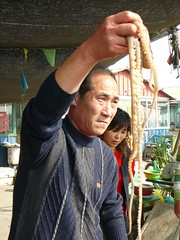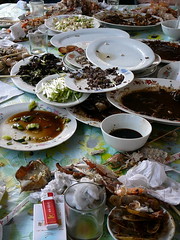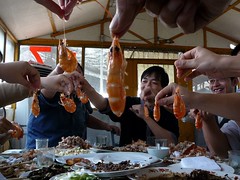Port of Tianjin
The Port of Tianjin (Tianjin Gang), formerly known as the Port of Tanggu, is the largest port in Northern China and the main maritime gateway to Beijing. The name "Tianjin Xingang" , which strictly speaking refers only to the main seaport area, is sometimes used to refer to the whole port. The port is on the western shore of the Bohai Bay, centred on the estuary of the Haihe River, 170 km southeast of Beijing and 60 km east of Tianjin city. It is the largest man-made port in mainland China, and one of the largest in the world. It covers 121 square kilometers of land surface, with over 31.9 km of quay shoreline and 151 production berths at the end of 2010.
Tianjin Port handled 500 million tonnes of cargo and 13 million TEU of containers in 2013, making it the world's fourth largest port by throughput tonnage and the ninth in container throughput. The port trades with more than 600 ports in 180 countries and territories around the world. It is served by over 115 regular container lines. run by 60 liner companies, including all the top 20 liners. Expansion in the last two decades has been enormous, going from 30 million tonnes of cargo and 490,000 TEU in 1993 to well beyond 400 million tonnes and 10 million TEU in 2012. Capacity is still increasing at a high rate, with 550–600 Mt of throughput capacity expected by 2015. The large volume of port traffic and high urban population makes Tianjin a Large-Port Megacity, the largest type of port-city in the world.
The port is part of the Binhai New Area district of Tianjin Municipality, the main special economic zone of northern China, and it lies directly east of the TEDA. The Port of Tianjin is at the core of the ambitious development program of the BNA and, as part of that plan, the port aims to become the primary logistics and shipping hub of North China.
On 12 August 2015, at least two explosions within 30 seconds of each other occurred at a container storage station at the Port of Tianjin in the Binhai New Area of Tianjin, China. The cause of the explosions was not immediately known, but initial reports pointed to an industrial accident. Chinese state media said that at least the initial blast was from unknown hazardous materials in shipping containers at a plant warehouse owned by Ruihai Logistics, a firm specializing in handling hazardous materials.
Location and layout
The Port of Tianjin is on the coast of Tianjin Municipality, in the former county of Tanggu, on the coast between the estuaries of the Haihe to the south and the New Yongding River to the north. To the west, the port borders the city of Tanggu (now the Urban Core of the Binhai New Area) and the TEDA. To the east, the port opens up to the Bohai Bay.
Tianjin Port is divided into nine port areas: the three core ("Tianjin Xingang") areas of Beijiang, Nanjiang, and Dongjiang around the Xingang fairway; the Haihe area along the river; the Beitang port area around the Beitangkou estuary; the Dagukou port area in the estuary of the Haihe River; and three areas under construction (Hanggu, Gaoshaling, Nangang).
Geophysical setting
The coastal area of Tianjin municipality before development was dominated by mudflats, salt marshes (and salterns), and coastal shallows. This littoral zone is wide and slopes gently: The 0 m isobath (the intertidal flats) extends to 3–8 km from shore at a slope of 0.71–1.28%, the −5 m isobath extends 14–18 km from shore, and the −10 m isobath reaches 22–36 km from shore. These features make deep water navigation dependent on extensive dredging, and it means that land reclamation is a cost-effective option for construction. Tianjin Port is by necessity largely man-made through dredging and reclamation.
History
The lower course and estuary of the Haihe is the main stem of a large navigable basin, as well as the westernmost seashore of the North China Plain, and there have been major ports on the area at least since the late Eastern Han Dynasty. The river port at the junction of the Grand Canal served as both an inland port and seaport supplying the northeast border of Chinese states. Since 1153, it was the critical supply hub for what is now Beijing.
However, it was not until after the conclusion of the Second Opium War in 1860 that the port of Tanggu became an important transshipment center, allowing oceangoing ships to lighter their cargoes to cross the very shallow sandbar barring the entrance to Haihe, the Taku Bar (大沽坝 — the name of this barrier was often used by foreign powers to refer to the entire port).
After the Boxer Rebellion, the whole of Tanggu came under foreign occupation, and those foreign powers developed an extensive network of quays on the riverside.
The capacity of the Tanggu and Tianjin river port was limited, and so the Japanese occupation forces started in 1940 the construction of the Tanggu Xingang seaport (later the Tianjin Xingang port) outside the river estuary. By the end of the war, the new port was incomplete, and damage during the Chinese Civil War left it unusable by the time of its capture in 1949.
The Communists reconstructed the Tanggu New Port slowly. On 17 October 1952, it reopened for traffic. At the time, the main channel was dredged to 6 m depth, could handle ships of up to 7,000 DWT and had an annual throughput of only 800,000 tonnes — less than 1/500 of present capacity. The port remained small throughout the Maoist era, although it pioneered the first container routes and dedicated container terminal in China.
The export boom that followed the post-1979 Reform and Opening period put enormous pressure on the rickety port infrastructure of China. Congestion became serious enough to force reform by the central government: On 1 June 1984, the Port of Tianjin was transferred from direct control of the Ministry of Communications to a "dual" system of shared central and local control.
Production then increased in leaps and bounds. In 1988 throughput passed the 20 million tonnes milestone, and in the ten years from 1993, annual throughput growth averaged 10 million tonnes every year. In December 2001, the port was the first port in north China to reach the 100 million tonnes mark. In 2004 it reached 200 million tonnes, in 2007 300 million tonnes and in 2010 400 million tonnes. The container handling capacity of the port increased from 0.4 million TEU in 1992, to 2.4 million TEU in 2002, 7.1 million TEU in 2007, and more than 10 million TEU in 2010.
The structure of the port also changed. In 1992, Tianjin Port Storage and Transportation Company was made into a joint stock company under the full ownership of the Tianjin Port Bureau. In 1996, it was converted into the Tianjin Port Holdings Company (TPC) and listed in the Shanghai stock market. In 1997, Tianjin Development Holdings, which owned the container-handling assets of the Port, was listed in Hong Kong. Its port assets were later spun out as the Tianjin Port Development Company (TPD) and listed in the Hong Kong exchange in 2006.
The PTA delayed corporatization to steer the passing of the 11th five-year development plan for the port. The transition was only completed on 3 June 2004, when the PTA became the last major Port Authority in China to become a corporation: the Tianjin Port (Group) Company (天津港(集团)有限公司, or TPG by its English acronym).
The financial tsunami of 2008 hit Chinese ports particularly hard, as they depended heavily on foreign trade flows. The Tianjin Port did better than average due to its diversification: While container business plummeted, bulk trade (in particular iron ore) remained strong. Nevertheless, the crisis hit profits hard, and it convinced the Tianjin government to reorganize and streamline the structure of the Port, which they did in 2009 by having TPD (the smaller operator, but one with the useful foreign registration and access to foreign capital markets) take over TPC. Simultaneously, ownership of TPD was transferred from Tianjin Development Holdings (a subsidiary of the Tianjin Ministry of Commerce) to TPG. By the time the merger was concluded, on 4 February 2010, all operations in the Tianjin Port had been consolidated under TPG.
The Port of Tianjin was adversely affected by a large industrial-scale accident in August 2015. On August 12, a series of explosions took place at a port chemical storage facility in Binhai, causing 173 deaths and nearly 800 injuries. The blast had the equivalent of 800 metric tonnes of ammonium nitrate or a magnitude-2.9 earthquake, according to the China Earthquake Networks Center. Eight other people remain missing.
The port is part of the Maritime Silk Road that runs from the Chinese coast to the south via the southern tip of India to Mombasa, from there through the Red Sea via the Suez Canal to the Mediterranean, there to the Upper Adriatic region to the northern Italian hub of Trieste with its rail connections to Central Europe and the North Sea.
Port fairway
The Tianjin Xingang is divided into the Main Shipping Channel, the Chuanzhadong Channel, and the Northern Branch Channel. The Dagusha Channel and the Haihe river channel are separate fairways with slightly different regulations.
Anchorages
Tianjin Port has six main anchorage areas and two temporary anchorages. All anchorages are designated for all functions — berth waiting, quarantine, inspection and pilotage — and provide little shelter from weather or rough seas. Bottom hold is poor to very poor. Anchored vessels are advised to keep five cables of clearance, as anchor dragging is common (up to 5–10 NM in a day in winter, due to drifting ice).
Shiplocks and tidal barriers
The Haihe river channel is separated from the sea channels by three structures:
- The Xingang Shiplock in the northern side of the estuary is the main shipping route into the Haihe area.
- The Haihe Tidal Barrier , built in 1958, and last refurbished in 1999, serves as a dam, flood control sluice and tide surge protection for the Haihe river mouth.
- The Tangg…
Looking for places related to Port of Tianjin?
Those are other destinations to find places related to Port of Tianjin:
- Summer Palace
- Temple of Heaven
- Capital Internation…
- Beihai Park
- Hotel
- Tsinghua
- Chaoyang Park
- Tiananmen
- Botanical Garden
- National Stadium
- Zhongguancun
- CCTV Headquarters
- Ming Dynasty Tombs
- Zoo
- Great Hall of the P…
- Wangfujing
- Peking
- Olympic Green
- National Centre for…
- China World Trade C…
- Tianjin
- Tianjin World Finan…
- Port of Tianjin
- Google China




















